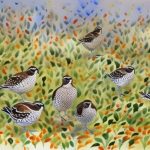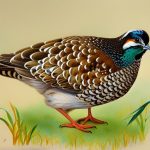Quail breeding is a popular and rewarding hobby for many people around the world. Quails are small, ground-dwelling birds that are known for their delicious eggs and meat. They are relatively easy to care for and can be raised in small spaces, making them an ideal choice for backyard farmers and homesteaders. Breeding quails can be a fun and educational experience, as it allows individuals to learn about genetics, animal husbandry, and the natural behaviors of these fascinating birds.
Quail breeding can also be a profitable venture for those looking to sell quail eggs or meat. With the increasing demand for organic and locally sourced food products, there is a growing market for quail products. Whether you are breeding quails for personal consumption or for commercial purposes, it is important to have a good understanding of the different quail breeds, their mating behaviors, and the factors to consider in breeding them. In this article, we will explore the world of quail breeding, including the different breeds of quails, their mating habits, and the best practices for successful breeding.
Key Takeaways
- Quail breeding is a popular practice for both hobbyists and commercial breeders due to the bird’s small size and low maintenance requirements.
- There are various quail breeds, each with unique characteristics and traits that make them suitable for different purposes such as meat or egg production.
- Different quail breeds can mate with each other, but it’s important to consider the potential outcomes and genetic implications before doing so.
- Factors to consider in quail breeding include genetics, health, and environmental conditions to ensure successful breeding and healthy offspring.
- Breeding quail for desired traits requires careful selection of parent birds and proper management to maintain the desired characteristics in the offspring.
Understanding Quail Breeds
There are several different breeds of quails, each with its own unique characteristics and traits. Some of the most popular quail breeds include the Coturnix quail, Bobwhite quail, Gambel’s quail, and California quail. The Coturnix quail, also known as the Japanese quail, is one of the most commonly raised breeds for egg and meat production. They are known for their high egg production, fast growth rate, and docile nature, making them an ideal choice for beginners.
Bobwhite quails are native to North America and are popular game birds. They are known for their distinctive call and are often raised for hunting purposes. Gambel’s quails are also native to North America and are prized for their beautiful plumage and sweet, tender meat. California quails are another popular breed known for their striking appearance and sociable nature. Each breed of quail has its own unique characteristics, so it is important to research the specific traits and requirements of the breed you are interested in breeding.
Can Different Quail Breeds Mate?
One common question that arises when breeding quails is whether different breeds can mate with each other. The answer is yes, different quail breeds can mate with each other and produce offspring. However, there are a few factors to consider when crossbreeding different quail breeds. First, it is important to ensure that the breeds you are crossing are of similar size and have compatible mating behaviors. For example, crossing a large breed of quail with a smaller breed may result in difficulties during mating and potential health issues for the offspring.
It is also important to consider the genetic traits of the parent breeds and how they may manifest in the offspring. Crossbreeding can result in a wide range of physical and behavioral traits in the offspring, so it is important to have a clear understanding of the desired traits you are aiming for in the breeding process. Additionally, some breeders may choose to crossbreed different quail breeds to create hybrid vigor, which can result in offspring that are more robust and resilient. However, it is important to approach crossbreeding with caution and careful consideration of the potential outcomes.
Factors to Consider in Quail Breeding
When breeding quails, there are several important factors to consider to ensure successful breeding and healthy offspring. One of the most important factors is providing a suitable environment for the quails to breed and raise their young. This includes providing adequate space, nesting materials, and a balanced diet to support the breeding process. Quails are social birds and thrive in groups, so it is important to provide a suitable social environment for them to engage in natural mating behaviors.
Another important factor to consider in quail breeding is genetics. It is important to select breeding stock with desirable traits such as high egg production, fast growth rate, and disease resistance. By carefully selecting breeding stock with these traits, breeders can improve the overall quality of their quail flock and achieve their breeding goals more effectively. Additionally, it is important to monitor the health and well-being of the breeding stock to ensure that they are in optimal condition for successful breeding.
Breeding Quail for Desired Traits
Breeding quails for desired traits requires careful planning and selection of breeding stock with the desired characteristics. One common trait that breeders aim for is high egg production. Quails are known for their prolific egg-laying abilities, and by selecting breeding stock with high egg production, breeders can improve the overall productivity of their flock. Other desired traits may include fast growth rate, docile temperament, and attractive plumage.
To breed quails for desired traits, it is important to have a clear understanding of genetics and how traits are passed down from parent birds to their offspring. This may involve conducting research on the genetic inheritance of specific traits and selecting breeding stock that carries these desirable traits. Additionally, breeders may choose to use selective breeding techniques to reinforce specific traits in their quail flock over multiple generations. By carefully selecting breeding stock and implementing selective breeding practices, breeders can work towards achieving their desired traits in their quail flock.
Challenges of Crossbreeding Quail

While crossbreeding quails can result in offspring with unique and desirable traits, there are also challenges associated with this breeding practice. One challenge is the potential for genetic abnormalities or health issues in the offspring resulting from crossbreeding different quail breeds. It is important to carefully consider the genetic compatibility of the parent breeds and monitor the health and development of the offspring to ensure they are healthy and thriving.
Another challenge of crossbreeding quails is managing the diverse range of traits that may manifest in the offspring. Crossbreeding can result in a wide range of physical and behavioral traits in the offspring, which may make it challenging to predict the outcomes of the breeding process. Breeders may need to carefully observe and evaluate the offspring to determine which traits are desirable and which may need further refinement through selective breeding practices.
Despite these challenges, crossbreeding quails can also offer opportunities for breeders to create unique hybrid varieties with desirable traits such as increased disease resistance or improved productivity. By carefully considering the potential challenges and outcomes of crossbreeding quails, breeders can work towards creating healthy and resilient offspring with the desired traits.
Best Practices for Quail Breeding
In conclusion, quail breeding is a rewarding and educational experience that offers opportunities for individuals to learn about genetics, animal husbandry, and natural behaviors of these fascinating birds. Understanding the different breeds of quails, their mating behaviors, and the factors to consider in breeding them is essential for successful breeding outcomes. Whether breeding quails for personal consumption or commercial purposes, it is important to carefully select breeding stock with desirable traits and provide a suitable environment for successful breeding.
Breeding quails for desired traits requires careful planning, selection of breeding stock with desirable characteristics, and an understanding of genetics and inheritance patterns. While crossbreeding quails can present challenges such as genetic abnormalities or diverse range of traits in offspring, it also offers opportunities to create unique hybrid varieties with desirable traits. By approaching quail breeding with caution and careful consideration of these factors, breeders can work towards achieving their breeding goals and creating healthy and resilient offspring with the desired traits.
If you’re interested in learning more about breeding quail, you may also want to check out this informative article on PoultryWizard about the mating habits of different breeds of quail. Understanding how different quail breeds mate can be essential for successful breeding and raising healthy quail flocks. To read more about this topic, visit PoultryWizard’s article on the mating habits of different breeds of quail.
FAQs
Can different breeds of quail mate?
Yes, different breeds of quail can mate with each other. Quail are known to be able to interbreed and produce offspring, although the success of mating and the fertility of the resulting eggs may vary depending on the specific breeds involved.
What are some examples of different quail breeds that can mate?
Some examples of different quail breeds that can mate with each other include the Coturnix quail (also known as Japanese quail) and the Bobwhite quail. These two breeds are commonly interbred to create hybrid quail for various purposes such as meat production or egg laying.
Are there any considerations to keep in mind when mating different quail breeds?
When mating different quail breeds, it is important to consider the potential genetic implications of crossbreeding. Care should be taken to ensure that the resulting offspring are healthy and do not have any genetic defects that could affect their well-being.
Can hybrid quail resulting from different breed mating be fertile?
In some cases, hybrid quail resulting from the mating of different breeds can be fertile and able to reproduce. However, fertility can vary depending on the specific breeds involved and may require careful selection and breeding to maintain desired traits in the offspring.
Meet Walter, the feathered-friend fanatic of Florida! Nestled in the sunshine state, Walter struts through life with his feathered companions, clucking his way to happiness. With a coop that’s fancier than a five-star hotel, he’s the Don Juan of the chicken world. When he’s not teaching his hens to do the cha-cha, you’ll find him in a heated debate with his prized rooster, Sir Clucks-a-Lot. Walter’s poultry passion is no yolk; he’s the sunny-side-up guy you never knew you needed in your flock of friends!







